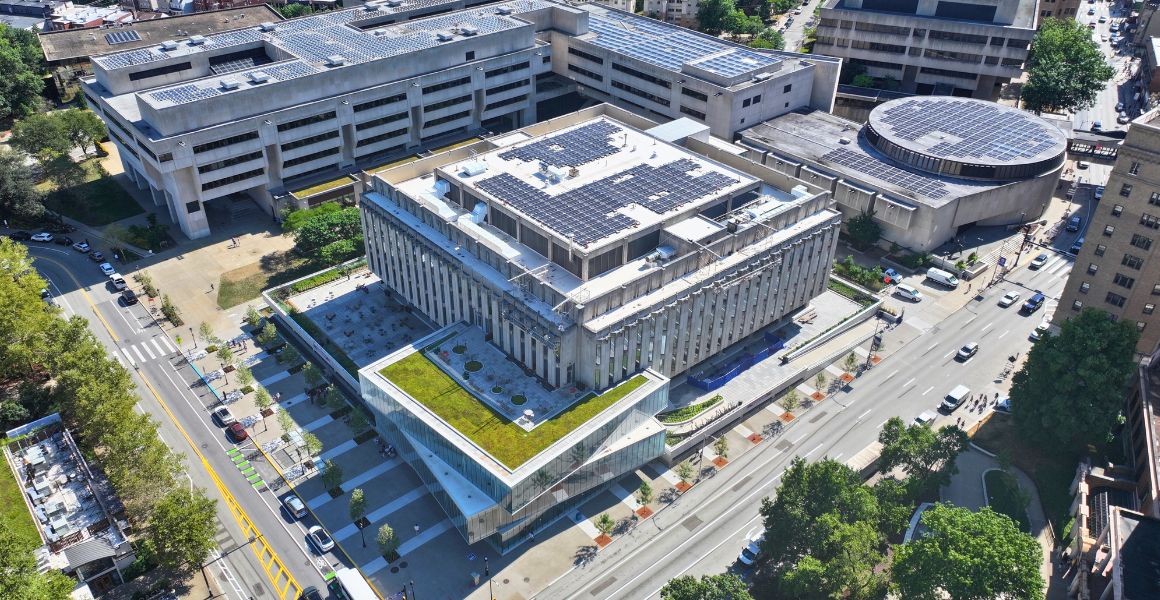
Since adopting the first Pitt Sustainability Plan in 2018 and Pitt Climate Action Plan in 2022, the University of Pittsburgh has been steadily advancing toward its 61 goals, including the commitment to source half of its electricity from renewable sources by 2030 and 100% by 2037.
In the past year, new rooftop solar panels were installed across 4 Pittsburgh campus buildings: David Lawrence Hall, Hillman Library, Ruskin Hall, and Posvar Hall. Combined with existing solar on Petersen Sports Complex, Pitt now has 2,042 solar panels producing electricity for 5 buildings in Pittsburgh’s Oakland neighborhood.
Alongside Pitt’s purchase of local electricity from the 20 megawatt Gaucho Solar farm, these efforts are expanding Pitt’s renewable energy portfolio. In recognition of this progress, the University received the Pennsylvania Solar Center’s Lodestar Award in 2023 and 2025.
Additional solar arrays are under construction and inspection at the Recreation and Wellness Center, Arena and Sports Performance Center, Center for Biotechnology and Bioengineering, Fifth and Halket, Scaife Hall, and BioForge at Hazelwood Green. By the end of 2025, Pitt expects to have 4,409 solar panels on 11 Pittsburgh buildings. The 2.47 MW of rooftop solar is expected to generate 3.1 million kWh of electricity from the sun annually – enough to power 176 homes (or all of the houses on Dawson Street). Producing this power locally will also save the University at least $300,000 annually.
Read on to learn about rooftop solar across the Pittsburgh campus.
Rooftop Solar in Operation
Petersen Sports Complex
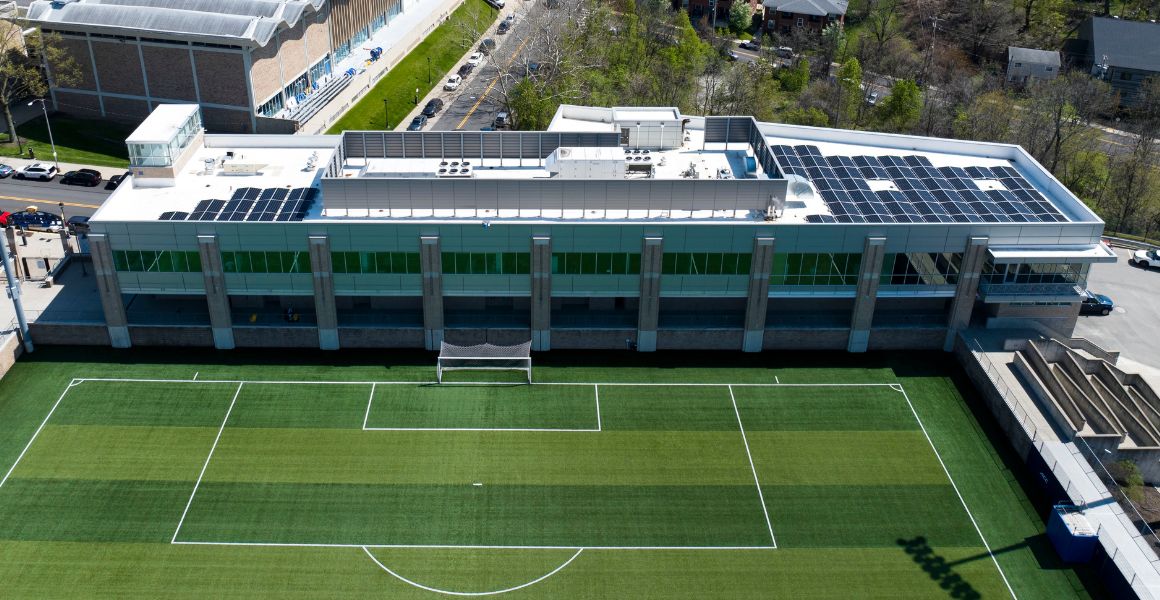
The completion of the LEED Silver Petersen Sports Complex (PSC) addition in 2022 added a white roof to the building to reduce heat gain alongside efficient indoor lighting and water fixtures. Because the building was designed and constructed “solar ready,” in 2024, PSC became the first Pittsburgh campus site to host new rooftop solar since 2012, marking the start of Pitt’s multi-year rollout of behind-the-meter rooftop solar arrays that directly power University buildings. Rooftop solar creates free, renewable electricity from the sun and avoids massive losses of electricity traditionally associated with transmission and distribution.
Specifications:
- 68.4 kW array with 120 solar panels
- Behind-the-meter system feeding directly into Pitt’s Oakland power grid
- Generated 72,250 kWh of electricity in the first 12 months of operation, enough to power 7.5 homes.
David Lawrence Hall
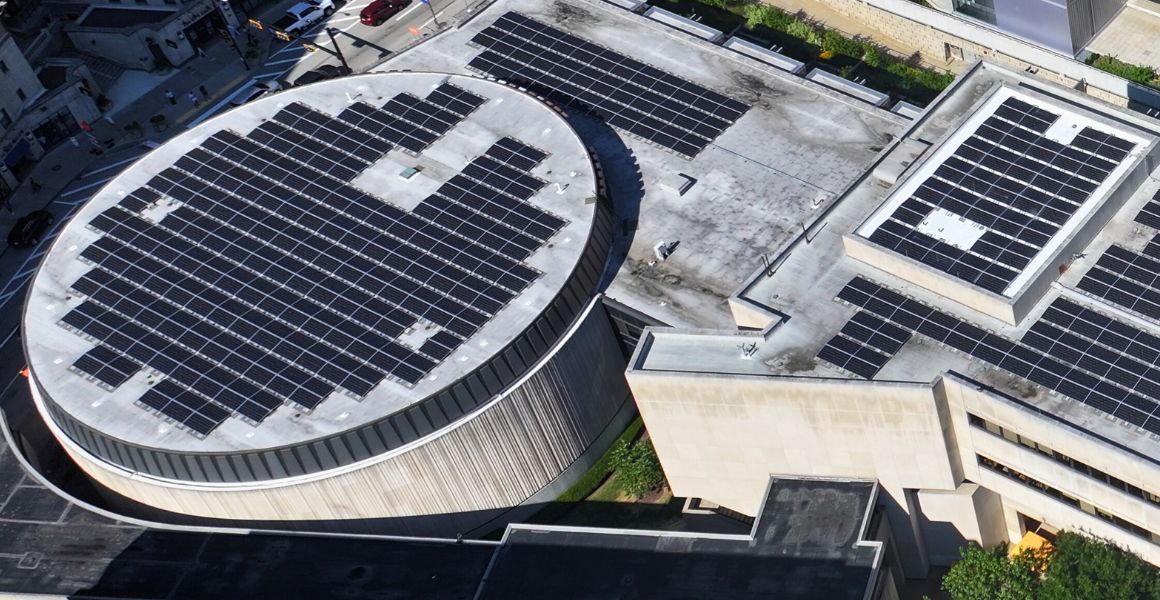
While pedestrian connections between David Lawrence and Wesley W. Posvar Halls are frequent, the two buildings’ rooftops are as well. Over the past year, Schenley Quad residents and William Pitt Union visitors have had the opportunity to see rooftop solar panels be added to David Lawrence Hall, interconnected with those on Posvar Hall. Even the circular roof over David Lawrence Hall’s large 120 and 121 classrooms now boasts rooftop solar.
Specifications:
- 205.2 kW array
- 360 panels
- Expected to produce 185,800 kWh annually, enough for 10.5 homes.
Hillman Library
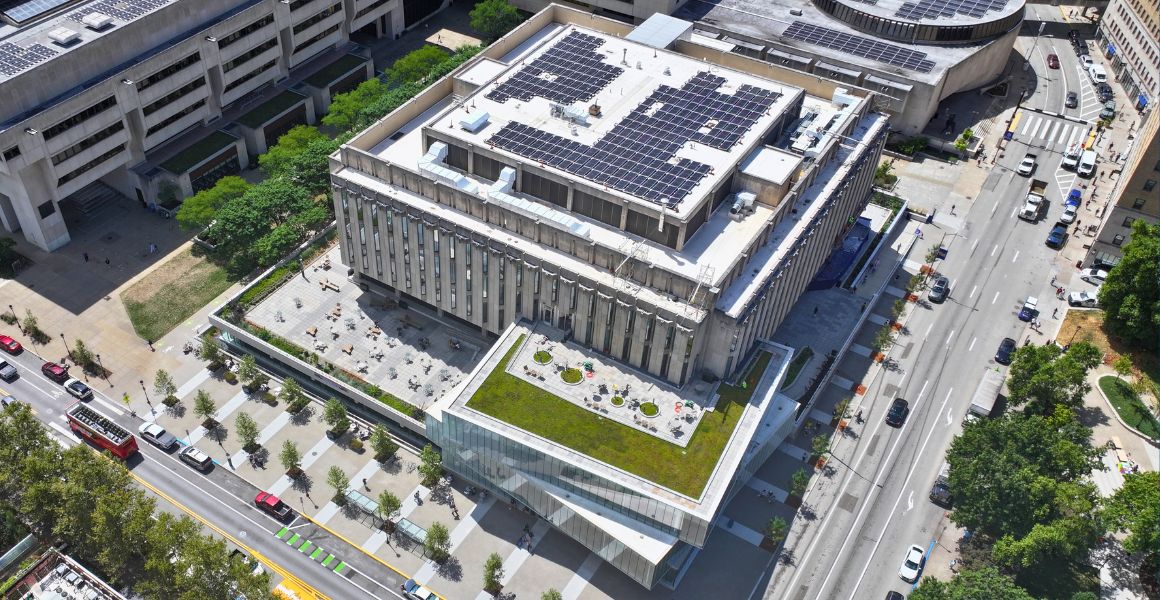
The multi-year Hillman Library renovation upgraded both library functionality and energy performance. The project just received a LEED Platinum designation, celebrating its efficient lighting, upgraded mechanical systems, new insulated windows, and green roof patios. A 133.7 kW rooftop solar array generates renewable electricity at the core of campus.
Specifications:
- 133.7 kW array
- 242 panels
- Expected to generate 168,800 kWh annually, enough to power 9.8 homes.
Posvar Hall
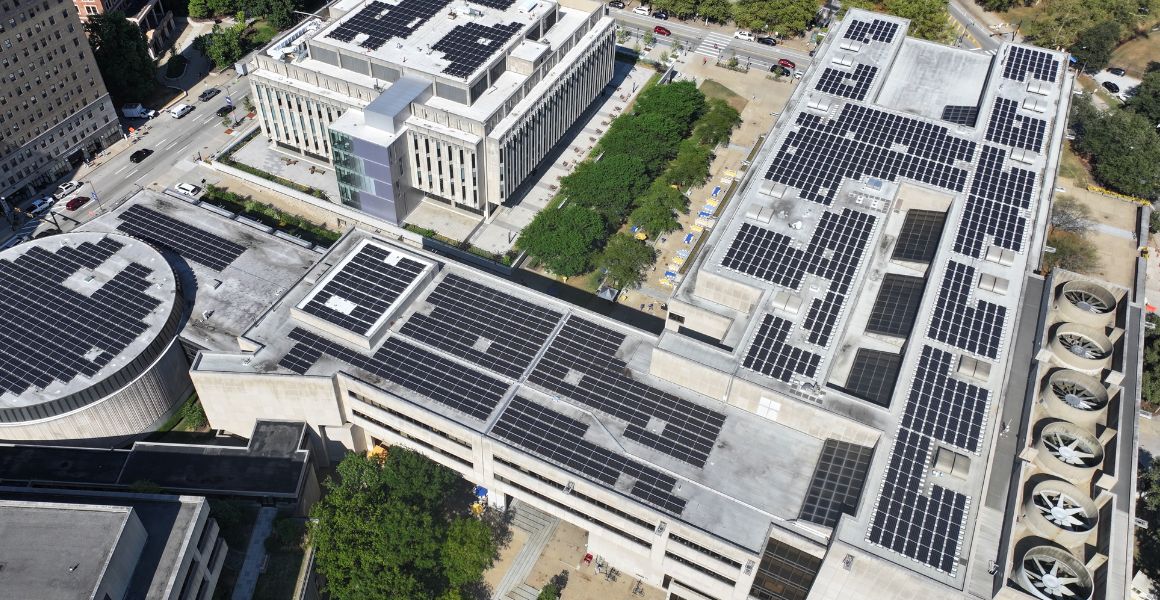
As the largest all academic building on campus, Posvar Hall now sports a 1,080-panel rooftop solar array. This new renewable electricity solidifies Posvar Hall’s status as a Pitt energy hub, given that the building also houses a chilled water plant and electrical substation, both supporting campus-wide energy use operations while integrating sustainable technologies. Posvar’s solar array complements numerous other sustainability features, including student-designed pollinator gardens, solar-powered picnic tables, and an anaerobic digester that converts organic materials to fertilizer.
Specifications:
- 615.6 kW array comprised of 1,080 solar panels
- Expected to generate 712,128 kWh, enough for 40.2 homes.
- Largest rooftop solar array possible on the Pittsburgh campus.
Ruskin Hall
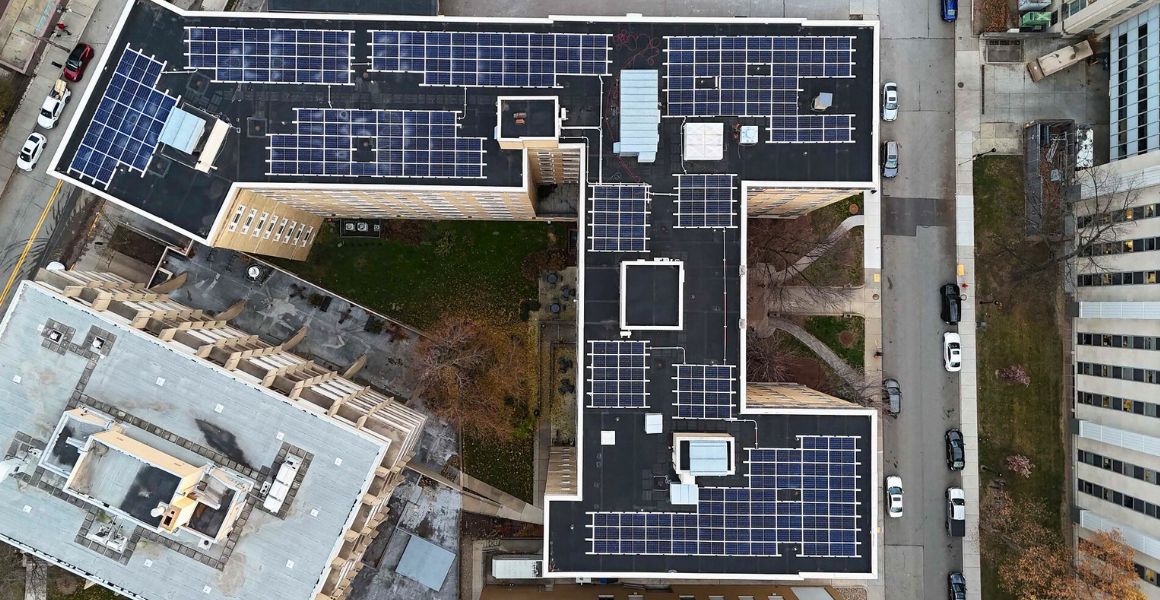
In 2024, Ruskin Hall was Pitt’s first residence hall to feature rooftop solar panels. The 240-panel array provides roughly 15% of the building’s electricity, the equivalent of common areas such as lounges, the fitness center, and hallways. By generating renewable electricity on-site, the solar array reduces reliance on grid power and avoids energy losses due to transmission and distribution.
Specifications:
- 136.8 kW array composed of 240 solar panels
Provides ~15% of the building’s electricity (nearly 156,000 kWh annually)
Rooftop Solar in Progress
Fifth and Halket
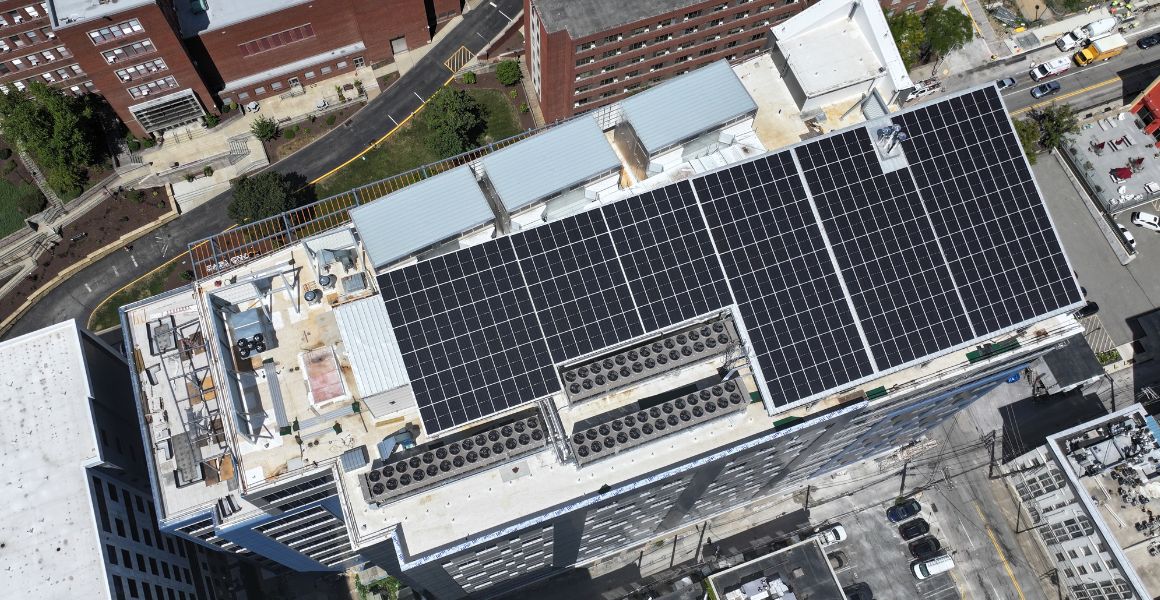
The new 10-story building at Fifth Avenue and Halket Street will consolidate the School of Health and Rehabilitation Sciences under one roof and features modern teaching and clinical facilities, wet labs, and the Pitt EDGE center. Designed with energy efficiency in mind, the building includes efficiency lighting and mechanical systems, a rooftop solar array, outdoor patios, an indoor bike room, and electric vehicle charging.
Specifications:
- 203.6 kW array of 351 individual solar panels
- Expected to generate 267,400 kWh annually.
Recreation and Wellness Center
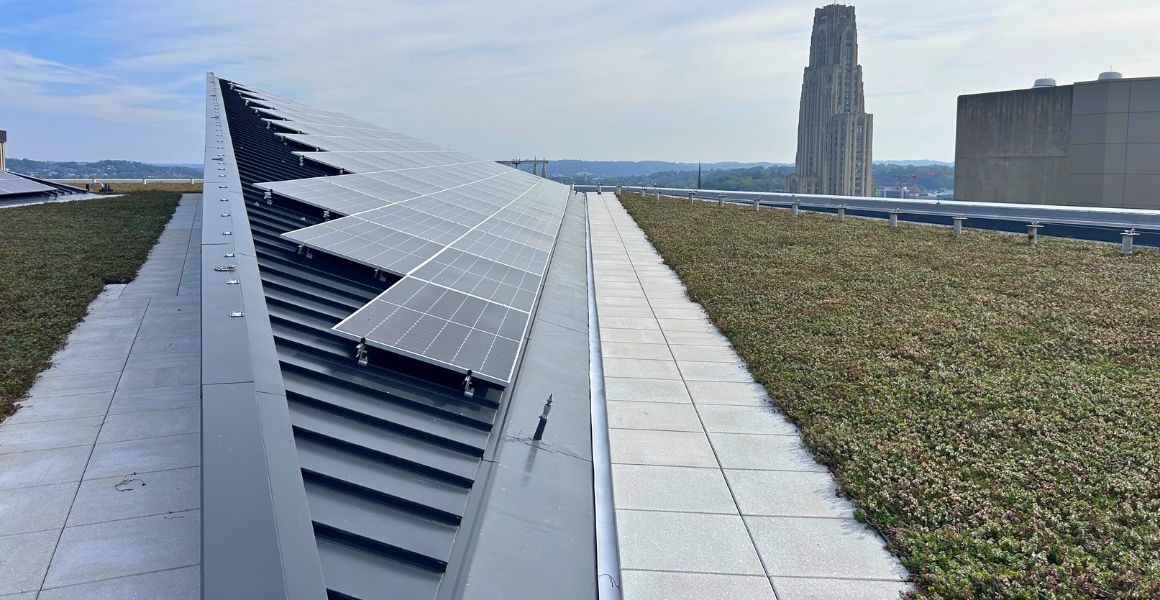
The new Recreation and Wellness Center added 270,000 square feet of health and wellness space to campus. Pursuing a LEED Gold certification, the building integrates energy efficient systems, biophilic design, rainwater collection, bird-friendly glass, and an extensive green roof that can be seen from upper campus. A 199 kW rooftop solar array complements these features, generating renewable electricity while supporting the center’s holistic approach to health, wellness, and sustainability.
Specifications:
- 199 kW array
- Rooftop solar covering 28,000 square feet
BioForge
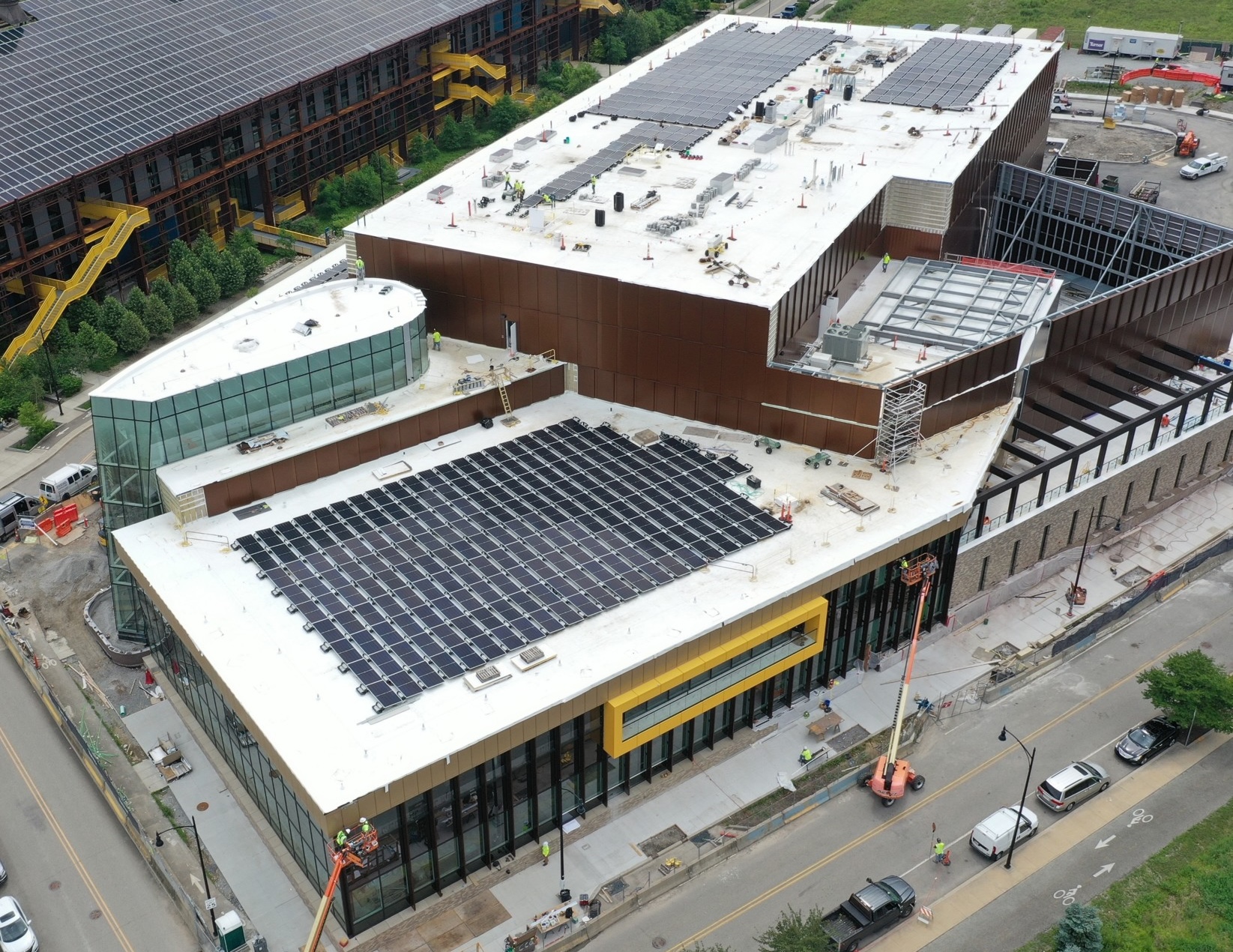
The new BioForge building at Hazelwood Green will house a state-of-the-art biomanufacturing facility and spark novel cell and gene treatments and therapies from concept to market. Pursuing LEED Gold certification or better, BioForge is located on a historic industrial brownfield site and helping continue Pittsburgh’s transformation into a sustainable, equitable, and inclusive model for urban development. With the building shell is nearing completion, the rooftop solar is nearly operational.
Specifications:
- 436.7 kW comprised of 794 solar panels
- Expected to generate 502,100 kWh annually, enough to power 52.2 homes.
Allen Magee Scaife Hall
Following the 2023 completion of the Scaife Hall addition and renovation, the building was solar ready. Pursuing LEED certification, the addition features natural light, a very efficiency building envelope, and efficient energy and water systems,
Specifications:
- 134.5 kW comprised of 244 solar panels
- Expected to generate 158,400 kWh annually
These rooftop solar installations show how Pitt is pairing campus upgrades with clean energy solutions to meet its sustainability goals. Learn more about solar at Pitt here.
